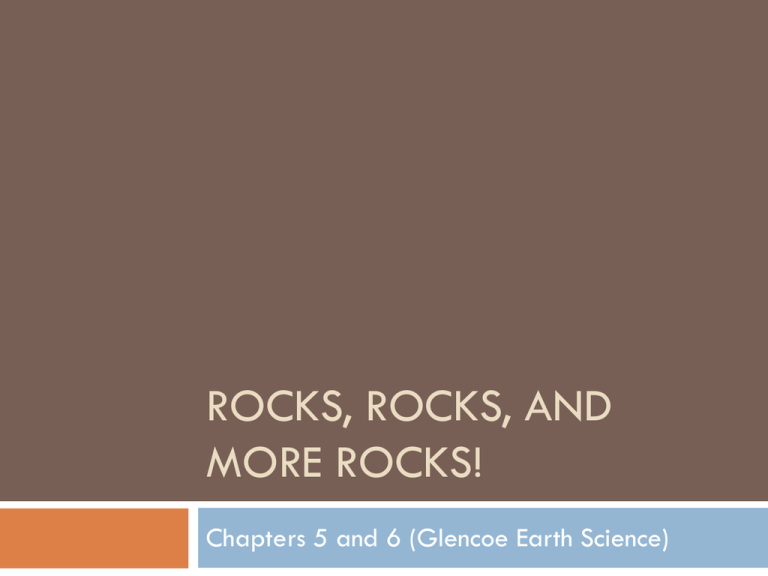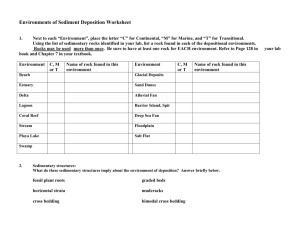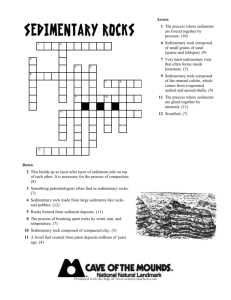rock - Eastern Wayne High
advertisement

ROCKS, ROCKS, AND MORE ROCKS! Chapters 5 and 6 (Glencoe Earth Science) What is a rock? A rock is a hard substance made of one or more minerals There are 3 types of rocks: Igneous Sedimentary Metamorphic What’s an Igneous Rock? Formed when magma crystallizes These rocks are associated with fiery lava flows Lava is magma that flows on the Earth’s surface Types of Igneous Rocks Extrusive Formed from lava on Earth’s surface that cools quickly Known as volcanic rock Fine-grained Intrusive Formed inside the Earth Magma rises up into pre-existing rocks and hardens Coarse-grained Called “Plutonic” rocks after Pluto, the god of the Underworld These rocks commonly produce landforms Granite is most common What About Igneous Rocks? Useful as building materials It’s Sedimentary, Watson! What’s a sedimentary rock? A rock formed from sediments Sediments are pieces of material that have been carried/deposited by wind, water, ice, gravity, or chemical precipitation. Sedimentary rocks form when these pieces are cemented together How do Sedimentary Rocks Form? Weathering Processes that break rock into smaller pieces Chemical-minerals in rock are dissolved or chemically changed Physical-minerals are unchanged; rock fragments break off Erosion Movement Caused of materials from one location to another by wind, moving water, gravity, glaciers (ice) Eroded materials almost always moved downhill Sediments, Classified Clastic Rock Refers to fragments of rock and minerals created by weathering and erosion Clastic comes from the Greek word for “broken” Classified by particle size Deposition Occurs when sediments are laid down on the ground or sink to the bottom of a body of water Largest particles settle first than smallest are last. Burial Most sediments are deposited in basins (depressions) As more sediments are deposited, the layers on the bottom are exposed to more heat and pressure. Causes lithification Physical and chemical processes that turn sediment into sedimentary rock Process of Lithification 1-Compaction Weight of sediments forces them closer together Water is squeezed out of mud Sand resists compaction because of grain-to-grain contact Process of Lithification 2-Cementation Temperatures increase Mineral growth cements sediments together into solid rock Features of Sedimentary Rock Horizontal layering (bedding) Graded bedding: particle size becomes more coarse/heavy toward bottom layers Cross-bedding: formed as inclined layers of sediment move forward across a horizontal surface Fossils Evidence of once-living organisms These are sedimentary rocks! Types of Sedimentary Rock (3 Types) Clastic Rock Most common; formed from deposits of loose sediments Types of Sedimentary Rock Chemical Rocks Formed when water evaporates leaving minerals behind Ex: Stalactites (upper), stalagmites (lower) Organic Sedimentary Rocks Formed from remains of a once-living thing Ex: limestone (Calcium Carbonate for seashells) Why are Sedimentary Rocks Important? It allows us a “snapshot” of surface conditions in Earth’s past. Energy Resources Coal, Oil, Natural gas are found in sedimentary rock Many metals are mined from sedimentary rocks Used in making cement (limestone) Used in making blocks for walls (sandstone, limestone) Metamorphic Rock When high temperature and pressure combine to alter the texture, mineralogy, or chemical composition of a rock without melting it. Metamorphism = Change and form This high pressure for a rock to become metamorphic can happen in 2 ways: Vertical Pressure caused by the weight of overlying rock Compressive forces generated as rocks are deformed during mountain building. The Rock Cycle Continuous changing and remaking of rocks Rocks are constantly being recycled from one type to another Example of the Path of a Rock Through the Rock Cycle Granite (igneous rock) Wind/rain erodes exposed rock, bits flake off, carried to bottom of stream carried to river, along with other sediments carried to sea, deposited Deposits build up form sandstone (sedimentary rock) Sediments continue to be buried and are under more pressure/higher temps pressed together even more form quartzite (metamorphic rock)AND THE CYCLE CONTINUES…







